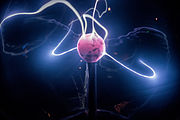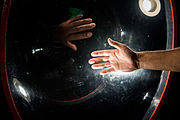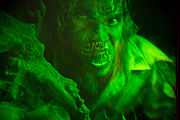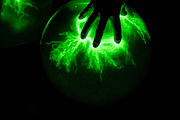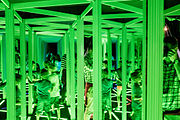Camera Obscura (Edinburgh)
Camera Obscura and World of Illusions is a tourist attraction in Old Town in Edinburgh , it is located in Castle Hill the Royal Mile next to Edinburgh Castle . Founder in 1835 was the entrepreneur Maria Theresa Short .
history
In the early 18th century, British instrument maker Thomas Short rented land on Calton Hill to show his instruments to the public. Since his lease stipulated that Thomas's female relatives could not inherit the building and its contents, his wife and children did not inherit it when he died in 1788. In 1827, Maria Theresa Short returned to Edinburgh from the West Indies , claiming to be the daughter of Thomas Short . From his inheritance, she wanted the telescope (“Great Telescope”), which she received despite great competition. In 1835 she built the observatory "Short's Popular Obersavatory" in a building near the National Monument of Scotland on Calton Hill . Short exhibited many scientific instruments here and the observatory was open every day until 9 p.m. "The observatory, which had become popular in the meantime, was closed by authorities against her protest in 1851 and she moved to Castlehill . In 1852 she bought the Laird of Cockpen's townhouse and added two stories to it. From 1853 to 1892 this new observatory was called Short's Observatory, Museum of Science and Art . The main attraction in "Short's Observatory" was the camera obscura in the top room. In the 18th century the mansion (it originally belonged to the Ramsays of Dalhousie , "Lairds of Cockpen") became small apartments, the main attraction of "Short's Observatory" was the camera obscura , which was located in the top room of the house. After Maria Theresa Short's death in 1869, her husband Robert Henderson continued the attraction.
In 1892 Patrick Geddes bought the museum and converted it. As part of the Old Edinburgh School of Art on Ramsay Lane, on the corner of Castlehill, Geddes' Short's Observatory has been renamed Outlook Tower . He integrated Maria Short's Camera Obscura and designed his exhibition Civic Survey of Edinburgh . Patrick Geddes was a staunch supporter of the exhibition as a carrier of education. While the exhibition was built and made available to the public, it was relatively short-lived and was never completed. "Later Geddes went to India, the Tower lost its magician and its place in the intellectual debate.
In 1945 the Camera Obscura was expanded and rebuilt. The University of Edinburgh owned the building from the 1940s to 1982 . In 1982 Visitor Centers Ltd. which also owns other tourist attractions, the building. This is now known as "Camera Obscura & World of Illusions". Two more floors were added in 2010 when the adjoining former “Ragged School” by Doctor Thomas Guthrie (1848) was incorporated into the attraction.
Camera Obscura and World of Illusions today
The tower, with its 6 floors of interactive exhibits, is still open to the public, making it the oldest purpose built attraction in the city and one of the oldest in the UK. Today references to Maria Short and Patrick Geddes can still be found on the top floor. The camera obscura is still used to organize a “virtual” city tour for visitors, and there are also very powerful telescopes on the roof terrace. On the other floors there is a wide variety of interactive exhibits on the subjects of optical illusions, light, color and types of vision. There are puzzles, mirror mazes and a vortex tunnel. Although the project is primarily positioned as a funhouse and tourist attraction, it also serves as a learning center about optical illusions, holograms, the origins of photography and about Edinburgh itself.
- Camera Obscura in Edinburgh
Other Outlook Towers and Camera Obscuras
The concept of the Outlook Tower has also been tried out elsewhere. When Patrick Geddes was 70, he moved to Montpellier . He bought land on a hill overlooking the city, built a house, and added another Outlook Tower. The building is today's Collège des Écossais. There are other camera obscuras in Bristol , Aberystwyth in Wales , and Kirriemuir and Dumfires in Scotland.
Individual evidence
- ^ A b Camera Obscura Edinburgh: History of the Attraction
- ^ Atlas Obscura

